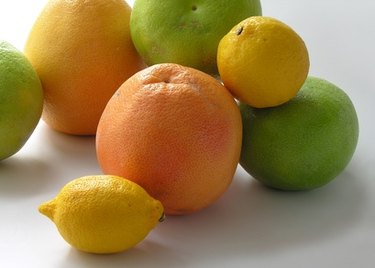
You may not have noticed that fruit trees lose their leaves in the winter months, but citrus (Rutaceae) trees do not. That's because they are evergreen, and while the harvest seasons for oranges, lemons, limes and grapefruit may have passed, underneath and inside the branches, stems and leaves, activity continues. The requirements for pruning citrus are different if the tree is young than if it's mature – and trimming citrus trees in Southern California, whether they're in a grove or a home garden, depends not only on the tree's age but also on the management of the tree as it grows.
Trimming Citrus Trees in Southern California
Video of the Day
Pruning citrus is critical for young trees. It regulates the structure and form of the tree, especially during its first two years of growth. It also controls the tree's size as you prepare for harvest. Start young to avoid an unpruned 15-year-old tree from becoming an eyesore or even unproductive. Do not prune more than 25 percent of the young tree's leaves, and observe its recovery over the subsequent two to four months. Remove suckers from the trunk area that deflect energy that should go to the citrus.
Video of the Day
Avoid pruning mature trees during flowering or fruiting as you're cutting away the crop. Wait until the season has passed. Do not stress the tree by pruning on hot summer days; further, don't prune during the cold winter, as the limbs and leaves are busy storing energy for the citrus. Cut off only 15 percent of the leaves of a mature tree. The canopy is particularly sensitive and should be trimmed to allow light, air and sun to reach the inner branches, but avoid allowing direct sunlight to penetrate the interior of the canopy.
Months for Pruning Citrus
February through April are the best months for pruning citrus trees in Southern California. Wait until the tree has stopped fruiting and before its starts flowering for the spring. Some citrus fruit early and some late, so gauge your haircuts by the tree's growth pattern. A good pruning keeps the tree at a manageable height. By trimming some of the emerging buds, the blossom quality and yield increase.
Using the right tools – shears, secateurs, hedging shears, a hand pruning saw and a file – provides your tree a healthy pruning and leaves the branches well-trimmed and smooth for the future. Remove branches that cross one another, and choose the healthiest to remain. Remove very low branches so that air circulation improves. In addition, pay attention to the skirt, that part of the tree that hangs low to the ground, keeping it at least 3 feet from the ground. If the trunk is exposed to harsh sun, paint it with a latex whitewash to prevent sunburn.
Admiring Your Southern California Citrus
Once you've completed your pruning and trimming, stand back and judge the balance of the branches. If you keep the trees small by using the hedging shears once a year, you'll find that more flowers and fruit are produced. Mulch and fertilize out to the dripline. This is also a good time to examine the trimmed leaves for any signs of disease.
Citrus trees thrive in full but indirect sun and in U.S. Department of Agriculture hardiness zones 7-11. Southern California is a prime location for citrus production, but the crops have been hit with the Huanglongbing (HLB) or citrus greening disease, and the only remedy is complete removal. Pruning has not proven to be effective. It's vital to continuously examine your trees and call the HLB hotline if you suspect the disease has infected your trees.